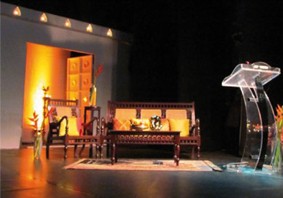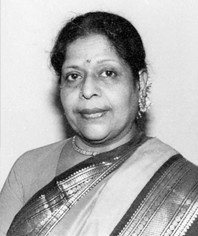COVER STORY - F.G. NATESA IYER (1880-1963) - T.S. Mani

A prominent patron of arts in 20th century south India, F.G. Natesa Iyer of Tiruchirapalli earned the gratitude of the Tamil population for his discovery and training of great artists like M.K. Thyagaraja Bhagavatar, K.B. Sundarambal and the T.K.S. Brothers. He projected M.S. Subbulakshmi as a child prodigy when she was 11 and arranged concerts for her with T. Chowdiah and Dakshinamoorthy as her accompanists. Who knows how many more such gems benefited from his training and guidance? His invaluable contribution in elevating terukoothu to sophisticated stage productions was the foundation on which the future of south Indian drama and cinema was solidly built.
The 1800s and 1900s saw many great achievers endowed with determination, patriotism, and belief in service before self, justice and fair play. They had humility and they shunned publicity, but they also had the burning desire to elevate the public to higher levels. F.G. Natesa Iyer had all these qualities.
SEASON 2011-12 - Season Potpourri - S. Janaki

What a transformation
On the topic of aesthetics, it was proved during the season that if you seriously apply your mind, you can achieve the impossible. As you walked into the Bharatiya Vidya Bhavan hall to attend the morning session of the Natya Darshan seminar convened by Anita Ratnam for Kartik Fine Arts, you gasped in wonder. The stage was transformed into a lovely space – a white temple façade with lamps placed in little alcoves. The dignitaries inaugurated the conference by opening the temple door to reveal a traditional oil lamp burning in the space bathed in soft yellow light. The elegant stage décor was the handiwork of Rex and Victor Paulraj who also combined stately wooden furniture with a modern acrylic rostrum on stage (see photo).
Passionate and divine
The confest on “Mad and divine Women” convened by Anita Ratnam (23rd to 25th December 2011) brought together many women passionate about their art and their calling. A highlight of the event was the presentation of the Lifetime Achievement Award to Vyjayantimala Bali. “Art is divine,” for this living legend, “a communion between the dancer and the Lord.” An ardent devotee of Sri Andal, Vyjayantimala unfailingly begins every performance, speech or lecdem by invoking Andal’s blessings. No wonder she was overwhelmed when presented with a huge special garland and a ‘leafy’ parrot from the Srivilliputtur temple along with the award. Much to the delight of the audience, the 78-year old got up with élan to present a charming depiction of select verses from Leela Sukar’s Krishnakarnamritam.
TRIBUTE - K.J. Sarasa, guru extraordinaire - Rathna Papa Kumar

K.J. Sarasa passed away on 2 January 2012 at Chennai after a brief illness. She was 77.
It was the sound of the tattukazhi on the palakai – the stick on the block of wood – that drew me to my neighbour’s house every day. A young woman, dark skinned and beautiful, with large expressive eyes, sat cross-legged on the ground,
hitting the stick, singing strange melodies and uttering mesmerising syllables that fascinated me to such an extent that I came home and repeated them, all the time imitating the teacher. Noticing my keen interest, my mother invited Teacher (K.J. Sarasa) home and requested her to take me under her wing. I was four years old when I started learning with her. She was still working for natyacharya Vazhuvoor Ramaiah Pillai, her mentor and surrogate father (she had lost her own when very young), but was willing to branch out on her own if given the chance. With my mother’s blessing, I became Sarasa’s very first student to be completely trained under her. My arangetram was the first she conducted as a nattuvanar in her own right. The first person she wanted me to honour, on stage, was Vazhuvoorar, who graciously attended and stayed through the whole programme, speaking very highly of the newly formed guru-sishya duo. It was one of the greatest blessings of my life.
Teacher was a magnanimous person. When she was sick or could not accompany me to a particular programme, she never made my mother cancel the show, but instead, requested S.K. Rajaratnam Pillai, Kameswaran, or Radhakrishnan to fill in. It was wonderful to see the understanding between these ‘guru bandhu-s’. Similarly, she would often take me and some of her other students to Vazhuvoorar’s house, to have ‘Master classes’ with him, telling us that he was the master teacher and the greatest of them all. On one such occasion, I learned the navarasa from the great maestro – a most unforgettable experience. It was her guru bhakti that taught us to have the same respect for our guru too.
A CENTENARY TRIBUTE - Eloquent in sound – and in silence - Alepey Venkatesan
This year marks the birth centenary of Palghat Mani Iyer (12 June 1912 to 30 May 1981), an all-time-great mridanga maestro who strode the Carnatic music scene like a colossus through most of the 20th century. He was a child prodigy who matured into a genius. Even so, he was never undependable or whimsical as a performer. He developed a unique style of his own; it represented a drastic, epoch-making departure from the prevailing role of the mridanga in music concerts in form, content and arresting presentation. He was a source of inspiration and role model to the great mridanga vidwans who came after him. To me and ever so many rasika-s, he was the most charismatic personality in the world of Carnatic music. He was held in awe not only by the next generation of musicians but even by his peers. Semmangudi Srinivasa Iyer said of him in a felicitation speech in 1973: “The equal of the ocean is the ocean alone; the equal of the sky is the sky alone; the equal of Mani Iyer is Mani Iyer alone”. Rangaramanuja Iyengar, vainika and musicologist, said: “It were madness to paint the lily, count the stars, sweeten honey or to fathom Mani’s colossal genius”. Mani Iyer embellished, enriched and enhanced to great heights the concerts of three generations of the finest musicians of his time.
Hallmarks of his artistry
The hallmarks of Mani Iyer’s artistry, were consistent alignment of the instrument with the tambura sruti; a versatility of tonality achieved through extraordinary care (with expense no object) which ensured that the mridanga could roar, croon, hum or even sing, as the mood of the music demanded; an unmatched, ambidextrous mastery over the instrument that he could deploy at will, on the spur of the moment, to excite, electrify, mesmerise or soothe; and uncanny anticipation of the intent of the singer. Barring sudden and spectacular bursts of inspiration, he maintained a simplicity of idiom which is characteristic of genius steeped in the classical ideal of “how” a thing is done in preference to “what” is done. His fine balance of technical intricacies and lilting sunada generated in equal measure the awestruck admiration of the learned and the lusty cheers of the laity. Deep awareness of and involvement in the music drove his laya manodharma. The range of his excellence was so sweeping and so comprehensive that it is difficult to make an exhaustive enumeration of the various elements.


